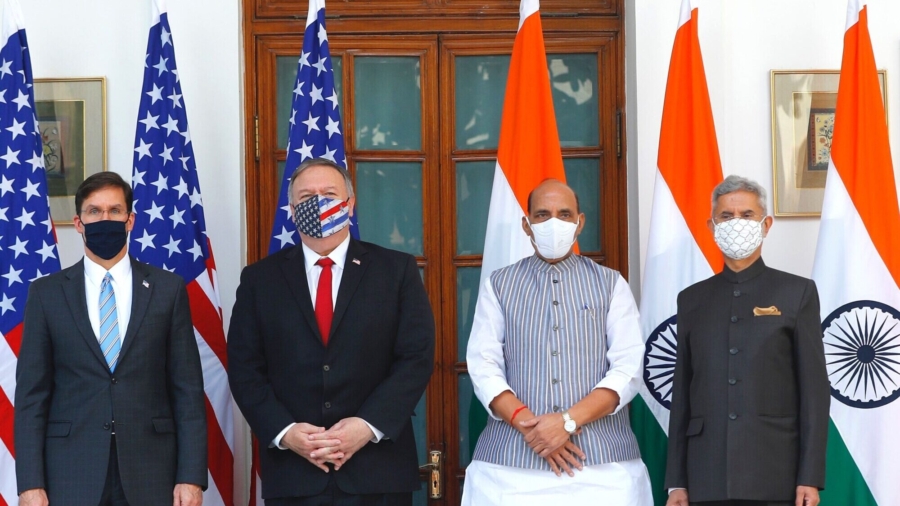The United States and India signed a pact to share sensitive satellite and map data on Tuesday as U.S. Secretary of State Mike Pompeo warned of the threat posed by the increasingly aggressive behavior of the Chinese regime.
U.S. Secretary of State Michael Pompeo and Secretary of Defense Dr. Mark Esper held third annual bilateral talks with their Indian counterparts in New Delhi on Tuesday to counter the threat the Chinese Communist regime posed to security and freedom.
The U.S.-India strategic dialogue comes at a time of heightened tension in the region, with Indian troops confronting Chinese forces on their disputed Himalayan border, where tens of thousands of soldiers have been engaged in a standoff since May.
The new defense pact—the Basic Exchange and Cooperation Agreement on Geospatial Cooperation—was a “significant milestone” that would foster cooperation between the militaries of both countries, Esper told the news conference.
Indian Minister of Defense Rajnath Singh called the agreement at a press conference “a significant achievement” in defense cooperation.
The agreement will expand geospatial information sharing between military forces, the U.S. State Department said in a statement.
The United States planned to sell more fighter planes and drones to India, Esper said. The pact will give India access to a range of topographical, nautical, and aeronautical data that is considered vital for targeting missiles and armed drones.
It would also allow the United States to provide advanced navigational aids and avionics on U.S.-supplied aircraft to India, an Indian defense source said.
“We stand shoulder-to-shoulder in support of a free and open Indo-Pacific for all, particularly in light of increasing aggression and destabilizing activities by China,” Esper said at the press conference of four ministers.
“Our leaders, and our citizens, see with increasing clarity that the Chinese Communist Party is no friend to democracy, the rule of law, transparency, nor to freedom of navigation, the foundation of a free and open, prosperous Indo-Pacific,” Pompeo said.
“When confronted by tyranny by the Chinese Communist Party, you can be sure that the United States will stand alongside its partners,” Pompeo said in an interview with Indian TV channel Times Now. The U.S. partnered with India to help deliver safety and security for the Indian people, for the Indo-Pacific, and even for the entire world,” Pompeo added.
Indian Foreign Minister Subrahmanyam Jaishankar said at the press conference that today it is particularly important to uphold a rules-based international order. “Together we can make a real difference when it comes to regional and global challenges, whether it is in respecting territorial integrity, promoting maritime domain awareness, counterterrorism, or creating prosperity,” he added.
Both defense ministers agreed on increased participation in joint military exercises and welcomed the inclusion of Australia in the U.S.-India-Japan MALABAR Naval Exercise which will be held in the Bay of Bengal and the Arabian Sea in November, the joint statement said.
Pompeo and Esper paid tribute to Indian troops killed in defense of their country, including 20 who were killed by the Chinese army earlier this year in an incident with China.

India maintains the largest fleets of C-17 and P-8 aircraft outside of the United States, and in 2020 the United States has authorized more than $20 billion in defense sales to India, the statement said.
U.S.-India Cooperation Potential
India has favorable conditions for “shifting production in the global supply chains in the wake of the disruptions due to the pandemic,” Singh said at the press conference.
“We invited original equipment manufacturers, other companies from the USA, to invest in India,” as the country has “very substantial requirements” in defense which can sustain investments for a long period of time, he added. In addition to the export of goods and services, India proposed the development of maintenance and repair facilities for American equipment that would serve the entire region, Sing said.
Both countries will continue their cooperation in countering terrorism and terrorism financing, as well as exchange information about sanctions, the joint statement said. They denounced the use of terrorist proxies, strongly condemned cross-border terrorism in all its forms, and will coordinate their actions against all terrorist networks such as al-Qaeda, ISIS, Hizb-ul-Mujahideen, and other, according to the joint statement.
Significant progress has also been made in energy partnerships including the project to build six nuclear reactors at a nuclear power plant in India by American company Westinghouse Electric, the four ministers said in the statement.
The United States also reaffirmed its continued strong support for India’s permanent membership in a reformed United Nations Security Council as well as for India’s early entry into the Nuclear Suppliers Group (NSG), according to the joint statement.
India has emerged as a leading regional and global power and next year will become a non-permanent member of the UN Security Council for a two-year term. The country seeks a permanent membership on the UN Security Council.
Agreements have also been signed between the two countries on cooperation in health science. An Indian research institution in the field of Ayurveda will cooperate with U.S. medical research and health institutions, according to the joint statement.
Both countries also cooperate in the higher education and science areas. The number of Indian students studying at American universities and colleges doubled since 2012 reaching 200,000 in the academic year 2018–19 the statement said.
From The Epoch Times

